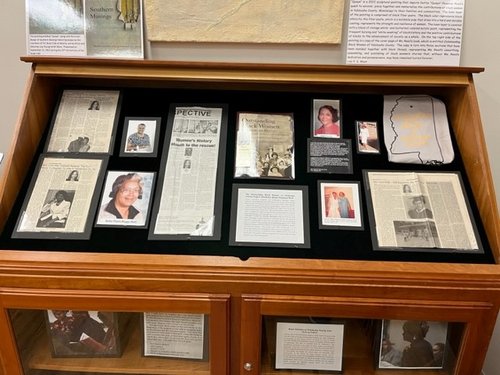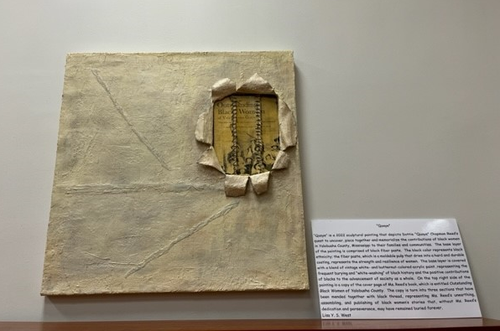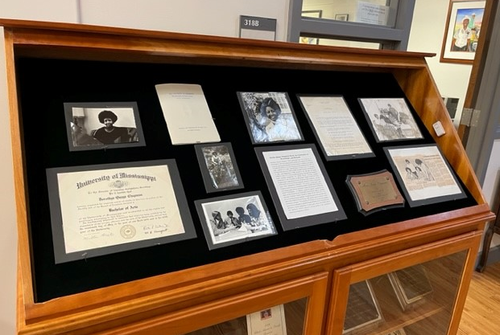Mississippians
In 2022, a physical exhibit in the Department of Archives and Special Collections was devoted to author, columnist, academic, and professional Dorothye Quaye Chapman Reed across two display cases.
The first case examined her project “Outstanding Black Women of Yalobusha County”. Chapman Reed described the motivation for her project as one which arose “from remarks …made at the funeral of my cousin, George Adams…People spoke of his immense love for Water Valley and about the impact that one Sunday School teacher had on their lives. That Sunday School teacher was my mom…I thought this might just be the time we pay tribute to many of those black women who impacted lives in such a way that we could still remember.”

In 2018, Ms. Chapman Reed began a series of articles in the North Mississippi Herald focusing on individual women who made a difference, shining light on their lives and legacy. The column also gave birth to a website (https://blackwomenofyalobusha.com/) and in 2020 Chapman Reed published the edited volume Outstanding Black Women of Yalobusha County: Their Stories and Their Contributions to a Mississippi Community. Described by columnist Curtis Weathers as “an extraordinary collection of inspiring stories of Black women,” the work draws upon the author’s impressive collection of articles, each focusing on particular outstanding women.

The 2022 sculptural painting “Quaye” by artist Lisa Y. S. West is also featured in the exhibit. Lisa Y. S. West’s artist statement describes the painting as depicting, “Dottie ‘Quaye’ Chapman Reed’s quest to uncover, piece together, and memorialize the contributions of black women in Yalobusha County, Mississippi to their families and communities.”
“Quaye” is a 2022 sculptural painting that depicts Dottie Quaye Chapman Reed’s quest to uncover, piece together and memorialize the contributions of black women in Yalobusha County, Mississippi to their families and communities. The base layer of the painting is comprised of black fiber paste. The black color represents black ethnic ethnicity; The fiber paste, which is a moldable pulp that dried into a hard and durable coating, represents the strength and resilience of women. The base layer is covered with a blend of vintage white and butternut-colored acrylic paint, representing the frequent burying and “white-washing” of black history and the positive contributions of blacks to the advancement of society as a whole. On the top right side of the painting is a copy of the cover page of Ms. Reed's book, which is entitled Outstanding Black Women of Yalobusha County. The copy is torn into three sections that have been mended together with black thread, representing Ms. Reed's unearthing assembling and publishing of black woman's stories that, without Ms. Reed's dedication and perseverance, may have been may have remained buried forever. (Lisa Y. S. West)
Black Families of Yalobusha County Oral History Project
During a visit to the University campus in 2019, Dottie Chapman Reed met with then University of Mississippi Professor, Dr. Jessie Wilkerson, to formulate an oral history project recording the lives of African American families from Yalobusha County. The project officially began on September 29th with six students from Dr. Wilkerson’s class conducting interviews in the towns of Water Valley and Coffeeville, Mississippi. Phase one culminated in late 2019 and early 2020, with a series of programs featuring Chapman Reed, Wilkerson, students, as well as interviewees. On display are articles about the December 2019 presentation at the Spring Hill North Mission Baptist Church.
Accompanying the articles are photographs by Operations Coordinator for the UM Sarah Isom Center for Women & Gender Studies, and noted photographer, Kevin Cozart. Other phases followed and the ongoing project histories are digitized, housed here in eGrove. (Link to Black Families of Yalobusha County)

Photographs of the reading in December 2019, All Our Names Were Freedom: Agency, Resiliency, and Community in Yalobusha County, are also featured in this display. The event at the Spring Hill M. B. Baptist Church was attended by approximately 70 community members, UM faculty and students, and six of the interviewees. Images by Kevin Cozart.
The second display case concentrated upon Chapman Reed’s time as a University student and admissions counselor, with articles about African American student life during the 1970s and original photographs.

Dorothye Quaye Chapman Reed graduated from the University of Mississippi in 1974 and subsequently served as the school’s first African American Admissions Counselor for several years. In addition, she served in leadership positions at East Tennessee State University from 1977 to 1981, worked as a sales representative at Dow Jones & Company, Incorporated sales from 1982 to 1996, founded a private consulting firm in 1992, and beginning in 1996, served as the Manager of Dodge Editorial, a part of The McGraw-Hill Companies, Incorporated.
Chapman Reed received recognition for raising African American student enrollment at the University of Mississippi, helped found the Black Student Affairs organization at East Tennessee State University, and has continuously promoted African American women’s history, among her many other noteworthy endeavors.

In addition, several of awards celebrating her legacy at the University are showcased, including the 2009 Dr. Jeanette Jennings Trailblazer Award, named in honor of the University’s first African American faculty member “recognizing alumni who served a vital role in the progress of black faculty, staff, alumni and/or students on the University’s campus.” The majority of the items featured in this display came from scrapbooks, curated by Chapman Reed, which she generously donated to Special Collections in recent years.
The finding aid for the Dorothye Quaye Chapman Reed Collection provides more detail about the "scrapbooks, correspondence, awards, certificates, newspaper clippings, writings, photographs, print material, and other materials related to Dorothye Quaye Chapman Reed’s life and career" that are kept in archival storage.
